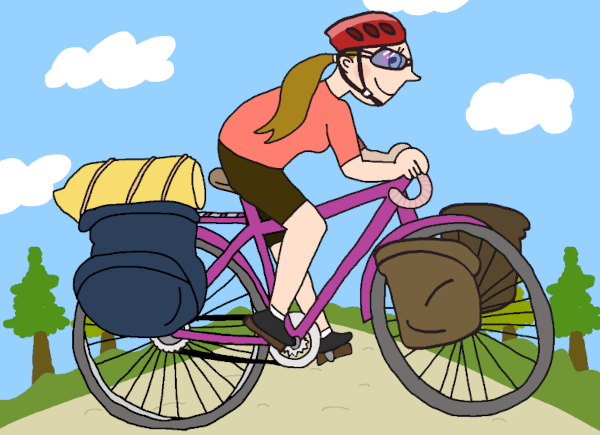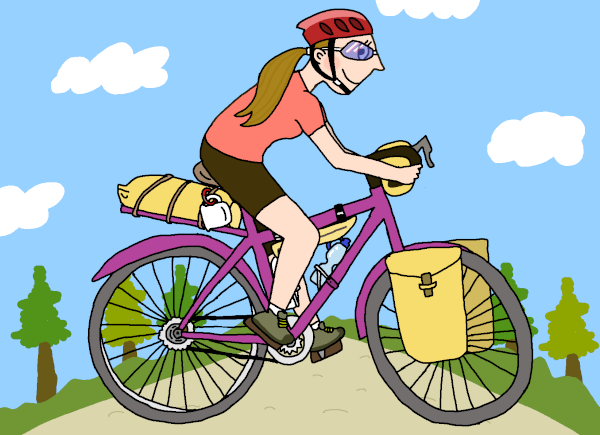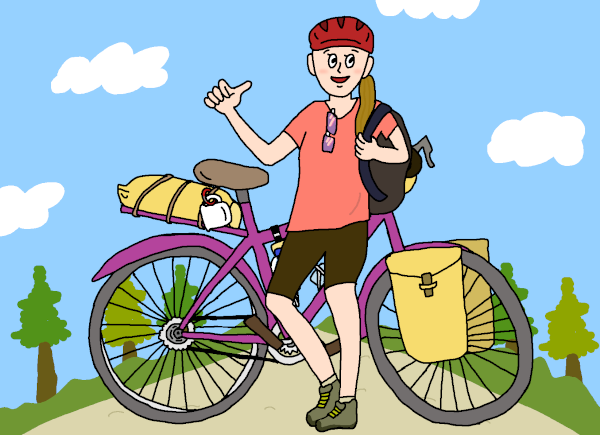Get out there!
Why Bike Tour?
Many aspects of bicycle touring have changed in the 30 years since I accidentally became a devotee. Examining paper maps is out, staring at a smartphone or other electronic gadget for navigation is in. Asking locals about their favorite restaurants is out, staring at a smartphone for recommendations is in. A chance encounter with a fellow traveler is out, constant communication with fellow travelers via smartphone is in. Although technology has reshaped bicycle touring, the fundamental concept fortunately remains unchanged: You pedal up the hills and down into the valleys, carrying enough payload to make you self-sufficient, and the world around you thinks that you are crazy.
Long-distance bicycle touring is one of my favorite ways to travel, and it might be for you too. The cyclist is both the passenger and the engine. Bicycling feels so good (most of the time), a physically and spiritually uplifting activity. A typical day of bike touring could lead you into peaceful meadows, through medieval towns, over wooded hills, and past grazing herds. Instead of whizzing past a pleasant spot in a car, you have time to slow down and stop, perhaps even change your route entirely. This way, you get to experience places that few other tourists see. Off the bike there is time for sightseeing and sampling the local cuisine. As a touring cyclist, you are vulnerable but also approachable. You could meet people of all ages and walks of life who are curious and eager to communicate with you. Had you arrived by car and approached somebody, they might have been suspicious. But the bicycle changes everything. Now most interactions are positive, the people you meet kind and helpful. In the evening, if you have not been invited to someone’s home, it’s time to find a camp spot, pitch the tent, cook a quick meal, and sleep. A typical day is simple and slow-paced, but seldom boring or uneventful.
Of course, there will be difficult days as well. Since you will be traveling without barriers to nature, you may find yourself in the thick of an insect swarm or fighting vicious headwinds from an approaching storm. You may find yourself stuck on a road with heavy traffic or having to deal with a bicycle repair. You may encounter aggressive motorists or hostile locals. You might feel scared, exhausted, or depressed. And you may ask yourself, “Well, how did I get here?”
Common Questions
Before leaving home for the first time, you will probably have doubts and fears about spending days, weeks, or even months on the open road. Here are some of the most asked questions:
Can my body handle it?
If you avoid exercise at all costs or can’t stand getting sweaty, sticky, hungry, wet, bruised, and sore at times, then bicycle touring is not for you. However, if you have a regular body and a basic level of fitness, then you are in a good place to get started. You don’t have to be an ultra-fit athlete to tour. Every day you will get stronger. The important part is starting off easy, perhaps 30 kilometers (20 miles) in a day. Your body will demonstrate its dissatisfaction by aching, but over time it will acclimate to daily cycling.
Literary Note
In A Bike Ride: 12,000 Miles Around the World (1994) Anne Mustoe perfectly captures the optimism that can overcome perceived physical limitations: “My arrangements made, I set out on 31 May 1987. I was 54, overweight, out of condition and I wobbled slightly on my unfamiliar bicycle. But my spirits were high. I know I was going to have a wonderful trip – and if things became too difficult, there was always plastic money to pay my air-fare home. After years of work and duty, I was setting out to unashamedly please myself. Even this book has been fun to write. Retracing my route in the comfort of my hotel in Southern Turkey, I sometimes marvelled at the hardships I endured, but more often I looked back with longing at those vibrant, carefree days.
Is bicycle touring boring?
The chances for boredom are greatest when the landscape becomes monotonous. Even the most pristine Scandinavian forests lose their charm after seeing them for days on end. Some bicycle tourists, usually less experienced ones, believe that they must pedal every kilometer on their route to feel a sense of achievement. Making use of trains, buses, or some other kind of motorized vehicle can be a great way to cut out boring (or dangerous) sections.
Is bicycle touring dangerous?
Any activity that involves exposure to the elements and vulnerability to external forces is inherently risky. Challenging terrain, illness, accidents, and bad people are all concerns. There are obvious hazards to consider when setting out to bicycle across Siberian ice fields or the immense plains of the Great Thar Desert. Even if you plan a tour close to home, mostly along backroads and cycle paths, you might end up cycling in pouring rain on a highway with no shoulder and countless 18-wheelers rumbling past. If you are wild camping, you may experience many uneventful nights, but one evening you might have unexpected visitors. In most situations, common sense will help you if you get into a scary situation. In short, be as well prepared as possible for the terrain you will encounter, don’t make your belongings an easy target of petty theft, feel empowered to take a bus or get a ride to a safer area, and although it’s a pain, sometimes you may need to quickly pack up your tent and find a better camping spot down the road.
Will I ever get to wash?
Personal hygiene is an issue for touring cyclists who are wild camping every night. The combination of dirt, dust, and sweat makes for a potent cocktail that only gets more pungent over time. In warm weather, it’s usually possible to use rivers, lakes, and oceans for bathing. In cold weather this is trickier, unless you happen to be in countries that have accessible hot springs, such as Japan and Iceland. You might have to rely on public restrooms or private homes. You should have a strong motivation to wash, both yourself and your clothing, as the downside of poor hygiene includes skin irritation that can make riding very painful.
Do I have to ride in bad weather?
No. You can do whatever you want – nobody is watching.
Bicycle Touring Versus Bikepacking
Historical Note
The term “bikepacking” was not widely used in the 1990s, when Eric Parsons started mountain bike touring in Alaska. Parsons and other pioneering riders began to think about alternate ways to transport their gear during their self-supported off-road adventures through the wilderness. This led Parsons to design ultralight, rackless touring systems, eventually founding Revelate Designs in 2008. The term “bikepacking” (not coined by Parsons) came to describe describe this new way of touring, which continues to gain popularity.
Bicycle Touring

“Bicycle touring” used to be a generic term used for any multi-day bicycle trip with gear aboard. Presently, the term usually refers to touring with fully loaded bikes built for comfort and stability, having racks for carrying panniers filled with gear. While the traditional realm of bike touring is a paved road or a well-maintained gravel path, any type of terrain can be traversed.
Bikepacking

As mentioned above, bikepacking has its roots in off-road excursions and adventure. Bikepackers use lightweight, versatile gravel or mountain bikes. They carry minimal gear in specialized bags that are attached to the frame, handlebars, and seat post. Bikepackers like to tackle rugged, remote routes and stay in backcountry campsites or wilderness areas. The selection of bikepacking bags and other equipment has exploded in recent years, allowing cyclists to ride over traditional bike touring terrain (paved roads and well-maintained gravel paths) with bikepacking setups.
Hitchbiking

Hitchbiking is a lesser-known and seldom documented form of travel, where well-meaning cyclists have all the equipment needed for serious bike touring or bikepacking but for a variety of reasons (inclement weather, terrible roads, lack of fitness) end up hitching rides on motor vehicles for the majority of their route.
Types of Bike Tours
Bicycle touring can take many forms, and you can shape it to best fit your needs. Dream about fulfilling your goals, be realistic about your strengths and weaknesses. Chances are your trip will fall into the three primary types of bicycle tours: self-supported, supported, and self-guided. The best fit depends on what you are looking for.
Self-Supported Touring
When I talked about why bike tour in the first place, I described self-supported touring. Usually either two or four panniers are loaded with clothes, supplies, tools, and cooking gear. A tent, sleeping bag, and pad are piled high as well. Evenings are often spent cooking humble meals over a stove, nights are spent in tents. However, there’s no need for masochism. If you want a break, you can eat at a restaurant. If the weather is bad or you need to sleep in a bed, you can spend the night at a hotel. In fact, “credit card touring” is a way to simplify trip logistics by paying more. Nights are spent in beds and all meals purchased. Not worrying about camping or cooking allows riders to transport minimal gear, such as extra clothing, snacks, and basic tools.
Supported Touring
In its simplest form, a supported tour is one where one person in a group drives a vehicle while the other group members ride. More commonly, supported tours are run by travel companies operating trips for small groups with predetermined itineraries. Pannier-free bicycles are provided for each participant, who is free to bike at their own pace. Included in the cost of these trips are experienced guides, all lodgings, all meals, baggage transfers, and a sag wagon to pick you up if you are too tired to continue.
Self-Guided Touring
In a self-guided tour, a commercial organizer usually supplies participants with a bicycle plus an attached GPS device to make route finding easy. Additionally, participants may receive route guides listing directions, hazards, food and drink recommendations, and points of interest. The organizer will book the accommodations and transfer the luggage every morning between hotels. The riding is completely self-paced, yet the organizer is reachable should the participants require assistance. Self-guided tours are a popular option for couples or small groups of friends.
